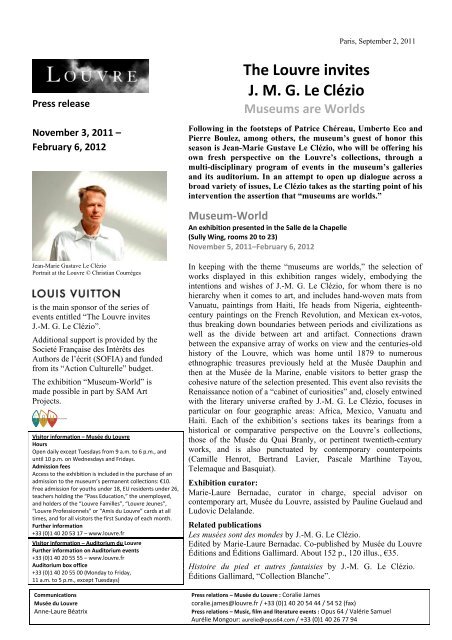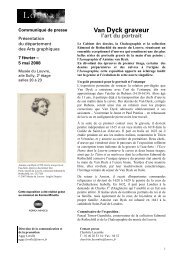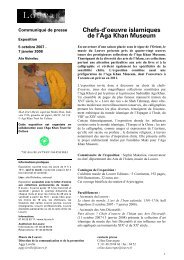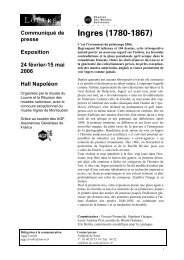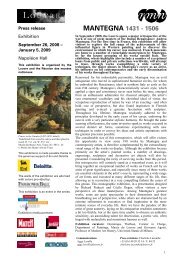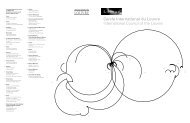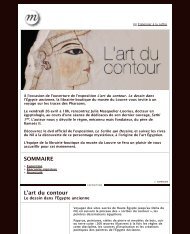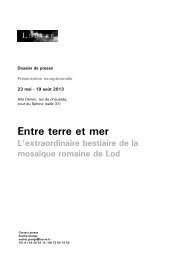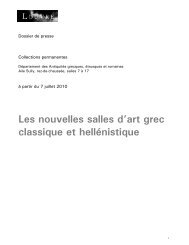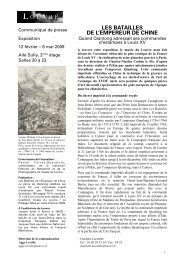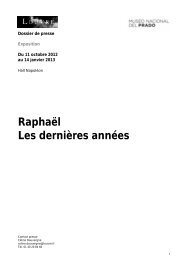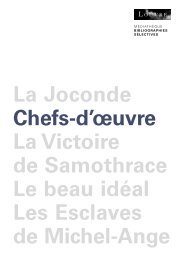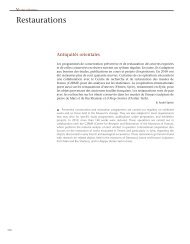In the Auditorium - Musée du Louvre
In the Auditorium - Musée du Louvre
In the Auditorium - Musée du Louvre
Create successful ePaper yourself
Turn your PDF publications into a flip-book with our unique Google optimized e-Paper software.
Press release<br />
November 3, 2011 –<br />
February 6, 2012<br />
Jean-Marie Gustave Le Clézio<br />
Portrait at <strong>the</strong> <strong>Louvre</strong> © Christian Courrèges<br />
is <strong>the</strong> main sponsor of <strong>the</strong> series of<br />
events entitled “The <strong>Louvre</strong> invites<br />
J.-M. G. Le Clézio”.<br />
Additional support is provided by <strong>the</strong><br />
Societé Française des <strong>In</strong>térêts des<br />
Authors de l’écrit (SOFIA) and funded<br />
from its “Action Culturelle” budget.<br />
The exhibition “Museum-World” is<br />
made possible in part by SAM Art<br />
Projects.<br />
Visitor information – <strong>Musée</strong> <strong>du</strong> <strong>Louvre</strong><br />
Hours<br />
Open daily except Tuesdays from 9 a.m. to 6 p.m., and<br />
until 10 p.m. on Wednesdays and Fridays.<br />
Admission fees<br />
Access to <strong>the</strong> exhibition is included in <strong>the</strong> purchase of an<br />
admission to <strong>the</strong> museum’s permanent collections: €10.<br />
Free admission for youths under 18, EU residents under 26,<br />
teachers holding <strong>the</strong> “Pass E<strong>du</strong>cation,” <strong>the</strong> unemployed,<br />
and holders of <strong>the</strong> “<strong>Louvre</strong> Familles”, “<strong>Louvre</strong> Jeunes”,<br />
“<strong>Louvre</strong> Professionnels” or “Amis <strong>du</strong> <strong>Louvre</strong>” cards at all<br />
times, and for all visitors <strong>the</strong> first Sunday of each month.<br />
Fur<strong>the</strong>r information<br />
+33 (0)1 40 20 53 17 – www.louvre.fr<br />
Visitor information – <strong>Auditorium</strong> <strong>du</strong> <strong>Louvre</strong><br />
Fur<strong>the</strong>r information on <strong>Auditorium</strong> events<br />
+33 (0)1 40 20 55 55 – www.louvre.fr<br />
<strong>Auditorium</strong> box office<br />
+33 (0)1 40 20 55 00 (Monday to Friday,<br />
11 a.m. to 5 p.m., except Tuesdays)<br />
The <strong>Louvre</strong> invites<br />
J. M. G. Le Clézio<br />
Museums are Worlds<br />
Paris, September 2, 2011<br />
Following in <strong>the</strong> footsteps of Patrice Chéreau, Umberto Eco and<br />
Pierre Boulez, among o<strong>the</strong>rs, <strong>the</strong> museum’s guest of honor this<br />
season is Jean-Marie Gustave Le Clézio, who will be offering his<br />
own fresh perspective on <strong>the</strong> <strong>Louvre</strong>’s collections, through a<br />
multi-disciplinary program of events in <strong>the</strong> museum’s galleries<br />
and its auditorium. <strong>In</strong> an attempt to open up dialogue across a<br />
broad variety of issues, Le Clézio takes as <strong>the</strong> starting point of his<br />
intervention <strong>the</strong> assertion that “museums are worlds.”<br />
Museum‐World<br />
An exhibition presented in <strong>the</strong> Salle de la Chapelle<br />
(Sully Wing, rooms 20 to 23)<br />
November 5, 2011–February 6, 2012<br />
<strong>In</strong> keeping with <strong>the</strong> <strong>the</strong>me “museums are worlds,” <strong>the</strong> selection of<br />
works displayed in this exhibition ranges widely, embodying <strong>the</strong><br />
intentions and wishes of J.-M. G. Le Clézio, for whom <strong>the</strong>re is no<br />
hierarchy when it comes to art, and includes hand-woven mats from<br />
Vanuatu, paintings from Haiti, Ife heads from Nigeria, eighteenthcentury<br />
paintings on <strong>the</strong> French Revolution, and Mexican ex-votos,<br />
thus breaking down boundaries between periods and civilizations as<br />
well as <strong>the</strong> divide between art and artifact. Connections drawn<br />
between <strong>the</strong> expansive array of works on view and <strong>the</strong> centuries-old<br />
history of <strong>the</strong> <strong>Louvre</strong>, which was home until 1879 to numerous<br />
ethnographic treasures previously held at <strong>the</strong> <strong>Musée</strong> Dauphin and<br />
<strong>the</strong>n at <strong>the</strong> <strong>Musée</strong> de la Marine, enable visitors to better grasp <strong>the</strong><br />
cohesive nature of <strong>the</strong> selection presented. This event also revisits <strong>the</strong><br />
Renaissance notion of a “cabinet of curiosities” and, closely entwined<br />
with <strong>the</strong> literary universe crafted by J.-M. G. Le Clézio, focuses in<br />
particular on four geographic areas: Africa, Mexico, Vanuatu and<br />
Haiti. Each of <strong>the</strong> exhibition’s sections takes its bearings from a<br />
historical or comparative perspective on <strong>the</strong> <strong>Louvre</strong>’s collections,<br />
those of <strong>the</strong> <strong>Musée</strong> <strong>du</strong> Quai Branly, or pertinent twentieth-century<br />
works, and is also punctuated by contemporary counterpoints<br />
(Camille Henrot, Bertrand Lavier, Pascale Marthine Tayou,<br />
Telemaque and Basquiat).<br />
Exhibition curator:<br />
Marie-Laure Bernadac, curator in charge, special advisor on<br />
contemporary art, <strong>Musée</strong> <strong>du</strong> <strong>Louvre</strong>, assisted by Pauline Guelaud and<br />
Ludovic Delalande.<br />
Related publications<br />
Les musées sont des mondes by J.-M. G. Le Clézio.<br />
Edited by Marie-Laure Bernadac. Co-published by <strong>Musée</strong> <strong>du</strong> <strong>Louvre</strong><br />
Éditions and Éditions Gallimard. About 152 p., 120 illus., €35.<br />
Histoire <strong>du</strong> pied et autres fantaisies by J.-M. G. Le Clézio.<br />
Éditions Gallimard, “Collection Blanche”.<br />
Communications Press relations – <strong>Musée</strong> <strong>du</strong> <strong>Louvre</strong> : Coralie James<br />
<strong>Musée</strong> <strong>du</strong> <strong>Louvre</strong> coralie.james@louvre.fr / +33 (0)1 40 20 54 44 / 54 52 (fax)<br />
Anne‐Laure Béatrix Press relations – Music, film and literature events : Opus 64 / Valérie Samuel<br />
Aurélie Mongour: aurelie@opus64.com / +33 (0)1 40 26 77 94
<strong>In</strong> <strong>the</strong> <strong>Auditorium</strong><br />
“Museums are venues inhabited by voices.<br />
Sometimes with a whisper, sometimes with<br />
<strong>the</strong> force of a full-piece orchestra. Always in<br />
step with <strong>the</strong> beat, <strong>the</strong> words to this music<br />
are spoken in all tongues. They coalesce and<br />
are given a new lease on life by each<br />
generation. Battlefields are <strong>the</strong> stillest places<br />
in all of History. But works of art are<br />
loquacious; <strong>the</strong>y are alive. They are not that<br />
different from <strong>the</strong> objects encountered in<br />
our daily lives. They resemble <strong>the</strong> Paris<br />
metro’s corridors and posters, public places,<br />
alcoves. They speak to <strong>the</strong> succession of<br />
ordinary days, life’s many mundane tasks,<br />
minor discomforts and little pleasures, <strong>the</strong><br />
efflorescence of birth, fate, paltry<br />
betrayals.”<br />
J.-M. G. Le Clézio<br />
Support provided by <strong>the</strong> Societé<br />
Française des <strong>In</strong>térêts des Authors de<br />
l’écrit (SOFIA) and funded from its<br />
“Action Culturelle” budget.<br />
Additional supported provided by <strong>the</strong><br />
<strong>In</strong>stituto Cultural de México and <strong>the</strong><br />
Quebec General Delegation in Paris.<br />
Pascale Marthine Tayou, Poupées Pascale, 2010,<br />
crystal and various materials. Courtesy of Galleria<br />
Continua, San Gimignano/Beijing/Le Moulin. Photo<br />
by Alicia Luxem.<br />
OPENING CONFERENCE by J.‐M. G. Le Clézio<br />
Thursday, November 3 at 7 p.m.<br />
As an intro<strong>du</strong>ction to <strong>the</strong> full series of events programmed, J.-M. G.<br />
Le Clézio delivers a keynote address presenting his <strong>the</strong>me “Museums<br />
are Worlds.”<br />
A concert by Chris Watson follows this presentation.<br />
With <strong>the</strong> assistance of INA-GRM.<br />
WRITERS CONFERENCE SERIES<br />
Moderated by Nathalie Crom of <strong>the</strong> magazine Télérama<br />
Four writers are invited to explore <strong>the</strong> ways in which <strong>the</strong>ir work<br />
resonates with <strong>the</strong> “o<strong>the</strong>r worlds” brought to <strong>the</strong> fore by J.-M. G. Le<br />
Clézio as <strong>the</strong> <strong>Louvre</strong>’s guest of honor this season, or with <strong>the</strong> ideas<br />
expressed by <strong>the</strong> author at his acceptance speech upon receiving <strong>the</strong><br />
Nobel Prize for Literature in 2008: “And now, in this era following<br />
decolonization, literature has become a way for <strong>the</strong> men and women<br />
in our time to express <strong>the</strong>ir identity, to claim <strong>the</strong>ir right to speak, and<br />
to be heard in all <strong>the</strong>ir diversity. … Culture on a global scale<br />
concerns us all.”<br />
Ananda Devi (born in Mauritius, lives in Switzerland)<br />
Monday, November 7 at 6:30 p.m.<br />
“Dualities”<br />
Homero Aridjis (born in Mexico, lives in London)<br />
Monday, November 14 at 6:30 p.m.<br />
“Persistence of a magical world”<br />
Alain Mabanckou (born in Congo‐Brazzaville, lives in <strong>the</strong> United States)<br />
Monday, November 21 at 6:30 p.m.<br />
“Le Clézio, a world literature writer?”<br />
Dany Laferrière (born in Haiti, lives in Montreal)<br />
Monday, November 28 at 6:30 p.m.<br />
“Haiti’s primitive painters: My first writing teachers”<br />
FACE TO FACE<br />
Pascale Marthine Tayou, in conversation with Thierry Raspail,<br />
director, <strong>Musée</strong> d’Art Contemporain de Lyon.<br />
Friday, November 18 at 8 p.m.<br />
A native of Cameroon, Pascale Marthine Tayou describes himself<br />
quite naturally as “a maker of images having fed off <strong>the</strong> African soil,<br />
but also sustained by o<strong>the</strong>r emotions, o<strong>the</strong>r scents, o<strong>the</strong>r universes.”<br />
For this event, he addresses <strong>the</strong> question of his own status as an<br />
“international African artist” while examining <strong>the</strong> identity<br />
contradictions created by globalization. He also discusses his interest<br />
in cross-pollination between art forms, <strong>the</strong>ir dissemination across<br />
borders, as well as his practice of reusing everyday objects and<br />
discarded materials in ways that sculpt memory.<br />
Camille Henrot, in conversation with Monique Jeudy-Ballini, CNRS,<br />
and Federico Nicolao, Ecole Cantonale d’Art de Lausanne (ECAL)<br />
and Ecole Supérieure d’Art (ESA) des Pyrénées.<br />
Friday, December 2 at 8 p.m.<br />
Camille Henrot presents her experimental film Coupé/Décalé,<br />
created from footage shot <strong>du</strong>ring a long odyssey through <strong>the</strong> Vanuatu<br />
archipelago showing young men jumping from tall wooden platforms<br />
with vines tied to <strong>the</strong>ir ankles. At this screening, she exchanges ideas<br />
with <strong>the</strong> anthropologist Monique Jeudy-Ballini on <strong>the</strong> fascination<br />
with o<strong>the</strong>r places, also addressing <strong>the</strong> issues raised by <strong>the</strong> reception<br />
and appropriation of cultural images as well as <strong>the</strong> ambiguities of<br />
cultural self-presentation.
<strong>In</strong> <strong>the</strong> <strong>Auditorium</strong><br />
Halil Altindere, My Mo<strong>the</strong>r Likes Pop Art, because Pop<br />
Art is Colorful, 1998 © Halil Altindere, Courtesy of <strong>the</strong><br />
artist and Pilot Gallery (Istanbul)<br />
“The history of art was invented in <strong>the</strong> West,<br />
tracing a direct line from primitive<br />
symbolism to <strong>the</strong> naturalist ideal in fifteenth-<br />
and sixteenth-century European painting.<br />
Thus was born <strong>the</strong> idea of <strong>the</strong> Renaissance,<br />
as if a number of dormant civilizations, <strong>the</strong>ir<br />
creativity stifled <strong>du</strong>ring <strong>the</strong> barbarous<br />
Middle Ages, had emerged from darkness to<br />
rediscover <strong>the</strong> truths of Antiquity. This lent<br />
credence to <strong>the</strong> notion of cultural hierarchy,<br />
<strong>the</strong> pernicious idea that made colonization<br />
possible, asserting <strong>the</strong> supremacy of one<br />
civilization or culture over all o<strong>the</strong>rs. Today,<br />
we know <strong>the</strong> price for having succumbed to<br />
this illusion. The seeming logic of its<br />
expressions (in art, but also through ritual<br />
beliefs and religion) is revealed as<br />
groundless at every turn and this must be <strong>the</strong><br />
very role fulfilled by museums.”<br />
J.-M. G. Le Clézio<br />
Exterior view of LaM (Lille Métropole <strong>Musée</strong> d’Art<br />
Moderne, d’Art Contemporain et d’Art Brut) and its annex,<br />
Villeneuve-d’Ascq. Photo by M. Lerouge/LMCU<br />
© Manuelle Gautrand Architecture<br />
SYMPOSIUM: “Museum(s)”<br />
Are compartmentalized museums a thing of <strong>the</strong> past?<br />
Saturday, November 19 from 10:30 a.m. to 6 p.m.<br />
Since <strong>the</strong> last quarter of <strong>the</strong> twentieth century, ethnographic museums<br />
have been <strong>the</strong> subject of lively debate over <strong>the</strong>ir reason for being in<br />
<strong>the</strong> postcolonial era and <strong>the</strong> purpose <strong>the</strong>y could conceivably serve in<br />
Western society in an age of cultural diversity and globalization. How<br />
are art museums affected by <strong>the</strong>se same issues? Do <strong>the</strong>y stand today<br />
as <strong>the</strong> bastions of cultural hierarchy helping to perpetuate <strong>the</strong><br />
Mediterranean region’s claims to cultural supremacy?<br />
As <strong>the</strong> <strong>Louvre</strong>’s guest of honor this season, Le Clézio offers a fresh<br />
approach to <strong>the</strong> art museum, as a museum-world enacting <strong>the</strong><br />
“materialization of memory.” According to his concept, “within <strong>the</strong><br />
museum’s walls, objects should be appreciated as outside time and<br />
not ranked according to subjective criteria. Knowledge is no longer in<br />
<strong>the</strong> ascendant. They are just works on display, that <strong>the</strong> will of single<br />
indivi<strong>du</strong>al, <strong>the</strong> energy of a city or a people has carried, shaped and<br />
laden with <strong>the</strong> <strong>du</strong>st of glory. Works that have survived through <strong>the</strong><br />
force of <strong>the</strong>ir convictions.”<br />
This revolutionary concept of <strong>the</strong> museum as “ei<strong>the</strong>r no man’s land or<br />
every man’s land, where cultures meet” raises not only <strong>the</strong> issue of<br />
<strong>the</strong> rules according to which collections are formed (which works<br />
today merit inclusion in an art museum’s collections?), but also <strong>the</strong><br />
ways in which <strong>the</strong>se works are presented to <strong>the</strong> public and enter into<br />
dialogue with each o<strong>the</strong>r. The aim here is not to discuss, from an<br />
anthropological perspective, <strong>the</strong> artistic qualities of non-Western<br />
artifacts, nor to return to <strong>the</strong> idea cherished by André Malraux, who<br />
argued that works of art underwent a process of constant<br />
metamorphosis by virtue of <strong>the</strong>ir inclusion in <strong>the</strong> museum context.<br />
This symposium focuses instead on <strong>the</strong> challenges faced by museums<br />
in a globalized world, and <strong>the</strong> new divisions between categories of<br />
collections that this entails.<br />
Program<br />
10:30 a.m. Opening remarks<br />
I. What guidelines should be followed by art museums in a<br />
globalized world?<br />
11 a.m. From “neuromuseology” to <strong>the</strong> future role of a world art<br />
museum: Moving from <strong>the</strong> museum providing answers to <strong>the</strong><br />
museum asking questions, John Onians, University of East Anglia,<br />
Norwich.<br />
11:30 a.m. Presentation of <strong>the</strong> “Global Art and <strong>the</strong> Museum”<br />
research project (GAM), Peter Weibel, Zentrum für Kunst und<br />
Medientechnologie, Karlsruhe.<br />
12 p.m. Extra-European objects in museums: Background and<br />
current issues, Nélia Dias, ISCTE/IUL, Lisbon.<br />
II. Decompartmentalizing museums by breaking down boundaries<br />
between collection categories<br />
2:30 p.m. When marginal art enters <strong>the</strong> museum, Savine Faupin,<br />
Lille Métropole <strong>Musée</strong> d’Art Moderne, d’Art Contemporain et d’Art<br />
Brut (LaM), Villeneuve-d’Ascq.<br />
3 p.m. Creating bridges between different collection categories:<br />
The architectural and museographic project for <strong>the</strong> LaM annex<br />
at Villeneuve-d’Ascq, Renaud Piérard, architect and museum design<br />
consultant, Paris<br />
4 p.m. Adaptable museums that charm visitors. Opening <strong>the</strong><br />
closed circle of Western art, Jean-Hubert Martin, honorary director,<br />
<strong>Musée</strong> National d’Art Moderne, Paris.<br />
4:30 p.m. At <strong>the</strong> Museum Kunstpalast’s Artists’ Museum: A<br />
contemporary perspective on <strong>the</strong> past, Bogomir Ecker, Thomas<br />
Huber, various artists, and Jean-Hubert Martin.
<strong>In</strong> <strong>the</strong> <strong>Auditorium</strong><br />
Pendant: Crucifixion and Descent from <strong>the</strong> Cross, 16 th<br />
century, Department of Decorative Arts, <strong>Musée</strong> <strong>du</strong><br />
<strong>Louvre</strong><br />
© RMN / Jean-Gilles Berizzi.<br />
“And what of <strong>the</strong> utterance that gives birth<br />
to art? If we are more sensitive to <strong>the</strong> voice<br />
behind each work of art, how much more<br />
can we feel when confronted with <strong>the</strong>se<br />
colors, bas-reliefs, glyphs and bodies made<br />
of stone? Then it needs to be reinvented,<br />
brought to <strong>the</strong> fore, studied closely,<br />
reimagining this utterance, working out its<br />
intentions. Ancient chants, myths, fables,<br />
poems, but also everyday noise, jokes that<br />
burst out everywhere, ribald language, plus<br />
fears and beliefs, narratives and romances,<br />
miracles, stories (as opposed to history),<br />
this fabric woven by human beings that has<br />
swaddled <strong>the</strong> world since <strong>the</strong> dawn of time.<br />
Not a single locus of action is free of this.<br />
It is deeply embedded in <strong>the</strong> memory of<br />
every indivi<strong>du</strong>al. And if we get it wrong in<br />
moving in so close, if we imagine too<br />
much, if we overplot <strong>the</strong> narrative, is that<br />
not where we find <strong>the</strong> truth of <strong>the</strong>se<br />
works?”<br />
J.-M. G. Le Clézio<br />
ART ON STAGE<br />
Franciscans among <strong>the</strong> Aztecs: Mexican microsculpture pendants,<br />
scenes from <strong>the</strong> Passion of Christ, 16 th century.<br />
Wednesday, November 16 at 12:30 p.m.<br />
Philippe Malgouyres, Department of Decorative Arts<br />
Pendants: Crucifixion, Descent from <strong>the</strong> Cross, Scenes from <strong>the</strong><br />
Passion of Christ. (Second third of <strong>the</strong> 16 th century, Mexico.<br />
Boxwood, rock crystal, gilt silver, Colibri fea<strong>the</strong>rs, pearls).<br />
Following <strong>the</strong> Spanish conquest, one of <strong>the</strong> most astonishing aspects<br />
of <strong>the</strong> history of Mexican art was <strong>the</strong> establishment, within<br />
e<strong>du</strong>cational institutions, of workshops to nurture and train artists. <strong>In</strong><br />
<strong>the</strong>se schools or seminars, <strong>the</strong> aboriginal peoples were taught music<br />
and <strong>the</strong> visual arts, in addition to <strong>the</strong> Spanish language. Members of<br />
religious communities had Christian devotion objects made of<br />
cornstalk pulp using pre-Columbian microsculpture techniques that<br />
had previously served to create works of art paying tribute to Aztec<br />
deities. Several such works will be analyzed and discussed in this<br />
hour-long session on <strong>the</strong> <strong>Louvre</strong>’s auditorium stage.<br />
ROUND TABLE<br />
Endangered manuscripts<br />
Thursday, December 1 from 6:30 to 9 p.m.<br />
Support provided by <strong>the</strong> Societé Française des <strong>In</strong>térêts des Authors de<br />
l’écrit (SOFIA) and funded from its “Action Culturelle” budget.<br />
The topic of discussion at this round table is <strong>the</strong> preservation of<br />
manuscripts by French-speaking authors, which would o<strong>the</strong>rwise<br />
have been lost to future generations after <strong>the</strong>ir deaths. Major efforts<br />
along <strong>the</strong>se lines are being pursued by <strong>the</strong> researchers of <strong>the</strong> <strong>In</strong>stitut<br />
des Textes et Manuscrits Modernes (ITEM). At this event, <strong>the</strong>y<br />
present four authors whose works face this predicament: <strong>the</strong><br />
Malagasy poet Jean-Joseph Rabearivelo (1901–1937), <strong>the</strong> Martinican<br />
poet and politician Aimé Césaire (1913–2008), <strong>the</strong> Congolese poet,<br />
dramatist and novelist Tchicaya U Tam’si (1931–1988), and <strong>the</strong><br />
Congolese novelist and poet Sony Labou Tansi (1947–1995).<br />
“French literary heritage in manuscript form is extremely fragile from<br />
a physical standpoint. It is prone to damage caused by water, fire, air,<br />
etc. But it is also exposed to o<strong>the</strong>r risks: how can a manuscript<br />
heritage survive military aggression, <strong>the</strong> brutal violence of forced<br />
displacement, or <strong>the</strong> more insidious attacks of economic predators?”<br />
This round table presents <strong>the</strong> challenges faced, <strong>the</strong> approach<br />
developed by ITEM, and <strong>the</strong> initial results of a vast program for <strong>the</strong><br />
preservation, promotion and publication of manuscripts by Frenchspeaking<br />
authors at risk of being lost.<br />
The event closes with readings from endangered manuscripts by<br />
Aimé Césaire, Jean-Joseph Rabearivelo, Sony Labou Tansi and<br />
Tchicaya U Tam’si.<br />
READING<br />
Personne<br />
Saturday, November 26 at 8 p.m.<br />
An evening event in <strong>the</strong> <strong>Auditorium</strong> devoted to a dramatic reading of<br />
Personne, excerpted from J.-M. G. Le Clézio’s new short-story<br />
collection entitled Histoire <strong>du</strong> pied et autres fantaisies, to be<br />
published in November by Éditions Gallimard.<br />
Artistic direction: Georges Lavaudant. Cast to be determined.<br />
Co-pro<strong>du</strong>ced by <strong>the</strong> <strong>Louvre</strong> and LG Théâtre – Georges Lavaudant.
<strong>In</strong> <strong>the</strong> <strong>Auditorium</strong><br />
Georges Lavaudant<br />
Peter Wispelwey © Benjamin Ealovega<br />
STAGE PLAY: PAWANA<br />
Friday, November 11 and Saturday, November 12 at 8 p.m.<br />
Sunday, November 13 at 4 p.m.<br />
Text by J.-M. G. Le Clézio. Directed by Georges Lavaudant.<br />
With Jérôme Derre and Philippe Morier-Genoud.<br />
An event co-pro<strong>du</strong>ced by <strong>the</strong> <strong>Louvre</strong> and LG Théâtre – Georges<br />
Lavaudant. The starting point of Pawana (which means “whale” in <strong>the</strong><br />
Nattick <strong>In</strong>dian language) is <strong>the</strong> story of a bloody hunt by <strong>the</strong> whaler<br />
Charles Melville Scammon. <strong>In</strong> <strong>the</strong> second half of <strong>the</strong> nineteenth<br />
century, this real-life indivi<strong>du</strong>al, whose character approaches <strong>the</strong><br />
legendary proportions of Herman Melville’s Captain Ahab, discovers<br />
a lagoon in Mexico, one of <strong>the</strong> last breeding refuges for gray whales.<br />
He decides to exterminate <strong>the</strong>m. The narrative weaves toge<strong>the</strong>r, in <strong>the</strong><br />
form of two monologues, <strong>the</strong> memories of <strong>the</strong> past and remorse of <strong>the</strong><br />
captain and his young cabin boy.<br />
More than twenty years after it was first staged in Mexico, in a<br />
Spanish-language pro<strong>du</strong>ction, <strong>the</strong> director Georges Lavaudant relishes<br />
<strong>the</strong> opportunity <strong>the</strong> return to this text he had commissioned from J.-M.<br />
G. Le Clézio, a dramatization of <strong>the</strong> author’s own short story. For this<br />
restaging at <strong>the</strong> <strong>Auditorium</strong> <strong>du</strong> <strong>Louvre</strong>, he has called upon <strong>the</strong> two<br />
actors who created <strong>the</strong>ir roles in <strong>the</strong> French-language version of<br />
Pawana, presented to great acclaim at <strong>the</strong> Avignon Festival in 1992.<br />
CONCERTS<br />
Friday, November 4 at 8 p.m.<br />
Mehdi Haddab, oud and Jean‐François Zygel, piano / Improvisation<br />
The improvisational pianist Jean-François Zygel joins <strong>the</strong> oudist<br />
Mehdi Haddab for an exploration of traditional <strong>the</strong>mes and <strong>the</strong><br />
classical repertoire.<br />
At <strong>the</strong> request of J.-M. G. Le Clézio, who dreamed up <strong>the</strong> idea of<br />
pairing <strong>the</strong> oud, an instrument he adores, with ano<strong>the</strong>r instrument,<br />
Mehdi Haddab and Jean-François Zygel welcome <strong>the</strong> opportunity to<br />
pursue <strong>the</strong> improvisational approach that will be <strong>the</strong> guiding principle<br />
of this special evening performance. Acoustic and electric instruments<br />
share <strong>the</strong> stage at this concert bringing toge<strong>the</strong>r two leading lights of<br />
<strong>the</strong> genre.<br />
“It’s funny. When you improvise, you need to be very attentive to<br />
what you’re doing, but also outside yourself, almost as if you had a<br />
split personality. You need to guide, lead and build while playing, and<br />
at <strong>the</strong> same time let go, allow something to emerge between <strong>the</strong><br />
superficial and <strong>the</strong> deeply rooted self.<br />
For me, music was certainly born of improvisation. That’s where <strong>the</strong><br />
musical discourse first saw <strong>the</strong> light of day, later to be codified on<br />
paper. Jazz musicians have made this <strong>the</strong> secret of <strong>the</strong>ir art. As<br />
classical musicians, it is our <strong>du</strong>ty to join <strong>the</strong>m, to recall that <strong>the</strong> secrets<br />
of all music may be traced back to improvisation.”<br />
Jean-François Zygel<br />
Friday, November 25 at 8 p.m.<br />
Peter Wispelway, cello J. S. Bach<br />
Six Suites for Unaccompanied Cello, BWV 1007–1012<br />
Concert with two intermissions.<br />
MUSIC ON FILM<br />
Boléro(s)<br />
Sunday, November 20 at 3 p.m.<br />
The celebrated work by Maurice Ravel is at <strong>the</strong> heart of J.-M. G. Le<br />
Clézio’s latest novel, Ritournelle de la faim. This event features a<br />
dramatic reading of an unpublished text on Boléro, accompanied by<br />
<strong>the</strong> screenings of an excerpt from Michel Follin’s 2008 documentary<br />
La Passion Boléro as well as a complete performance of Boléro under<br />
<strong>the</strong> baton of Sergiu Celibadache, who has a particularly trancein<strong>du</strong>cing<br />
approach to this work.
<strong>In</strong> <strong>the</strong> <strong>Auditorium</strong><br />
The Passion of Joan of Arc (1928) by Carl Theodor<br />
Dreyer © Gaumont<br />
“The essential human nature of<br />
cinematographic art does not lie in a rallying<br />
call to revolution nor <strong>the</strong> promise of an<br />
eternal, undying love. <strong>In</strong>stead, it is in <strong>the</strong><br />
chaos of ideas and images, perpetually in<br />
uproar and in flux, coming from all<br />
directions and envelopping us, jumbling up<br />
<strong>the</strong> past and <strong>the</strong> present, <strong>the</strong> true and <strong>the</strong><br />
unattainable, fun, lightness and cruelty.”<br />
J.-M. G. Le Clézio, Ballaciner<br />
Yeelen (1987) by Souleymane Cissé © Les<br />
Films Cissé<br />
FREE ELECTRON(S)<br />
Wednesday, November 23 at 8:30 p.m.<br />
An event programmed as part of <strong>the</strong> “Free Electron(s)” series,<br />
confronting visual and sound materials to channel new energies.<br />
The Passion of Joan of Arc<br />
Directed by Carl Theodor Dreyer.<br />
France, 1928, about 80 min., black and white, silent.<br />
First performance of an original electronic music composition by<br />
Bot’Ox (Cosmo Vitelli and Julien Briffaz).<br />
Commissioned by <strong>the</strong> <strong>Musée</strong> <strong>du</strong> <strong>Louvre</strong> (2011).<br />
At <strong>the</strong> suggestion of J.-M. G. Le Clézio, Bot’Ox offers a fresh<br />
perspective on <strong>the</strong> masterpiece by <strong>the</strong> great Danish filmmaker.<br />
FILMS<br />
Nice, early 1940s. Far from <strong>the</strong> chaos of <strong>the</strong> world outside, in <strong>the</strong><br />
comforting darkness of <strong>the</strong> hallway in his grandmo<strong>the</strong>r’s apartment, a<br />
little child contemplates in utter fascination <strong>the</strong> colored images<br />
projected by <strong>the</strong> pale and trembling light of <strong>the</strong> magic lantern, <strong>the</strong> one<br />
“giving rise to dreams, visions, apparitions and ghosts.” A few years<br />
later, <strong>the</strong> war comes to an end. O<strong>the</strong>r luminous and more “realistic”<br />
images jostle against each o<strong>the</strong>r in <strong>the</strong> hallway, in films that <strong>the</strong> child,<br />
now grown, projects himself on a plain white bedsheet using a Pathé<br />
Baby projector: slapstick comedies, documentaries and cartoons,<br />
provided by Gaby, one of his grandmo<strong>the</strong>r’s cousins, who had<br />
worked at Pathé.<br />
“It was <strong>the</strong>n, while projecting and viewing those films, that I<br />
experienced aes<strong>the</strong>tic emotion for <strong>the</strong> very first time,” reveals J.-M.<br />
G. Le Clézio. What he discovered at that time was “cinema as an<br />
opening to <strong>the</strong> world”, “this flux coming from all directions and<br />
envelopping us, jumbling up <strong>the</strong> past and <strong>the</strong> present, <strong>the</strong> true and <strong>the</strong><br />
unattainable, fun, lightness and cruelty.” Soon, <strong>the</strong>se projections<br />
become genuine programmed events, to which he invites his friends<br />
using posters he designs himself. Then come <strong>the</strong> adolescent years and<br />
his first experiences as a moviegoer, two or three times a day in <strong>the</strong><br />
cinemas and film-clubs of his native Nice.<br />
When this avid film buff later becomes a writer, preferring in <strong>the</strong> end<br />
<strong>the</strong> great freedom offered by words to <strong>the</strong> flood of images, he never<br />
stops nurturing his passion and eventually devotes a book to this<br />
subject, a promenade in tribute to <strong>the</strong> “dream machine” entitled<br />
Ballaciner, published in 2007. <strong>In</strong> it, he speaks of his fascination for<br />
“shadow <strong>the</strong>ater” and of his first hero, Harold Lloyd, as well as his<br />
encounters with Dreyer, Ozu, Vigo, Pasolini, Bergman, Antonioni,<br />
with Japanese, <strong>In</strong>dian, African, Iranian, Korean and o<strong>the</strong>r cinemas, all<br />
of this overwhelming humanity.<br />
Cinema, as adored by J.-M. G. Le Clézio is a “chaos of ideas and<br />
images,” <strong>the</strong> world’s enchantment and voice, as evidenced by <strong>the</strong><br />
selected films in this program.
<strong>In</strong> <strong>the</strong> <strong>Auditorium</strong> and<br />
<strong>the</strong> Audiovisual room<br />
under <strong>the</strong> Pyramid<br />
Dersu Uzala (1975) by Akira Kurosawa © Arkeion<br />
Films<br />
The Music Room (1958) by Satyajit Ray © Films Sans<br />
Frontières<br />
Carte Blanche to J.‐M. G. Le Clézio<br />
Saturday, November 5 at 2:30 p.m.<br />
Presentation by J.-M. G Le Clézio.<br />
Dersu Uzala by Akira Kurosawa<br />
Japan/USSR, 1975, 141 min. color, French subtitles.<br />
Based on <strong>the</strong> memoirs of <strong>the</strong> Russian explorer Vladimir Arseniev, who<br />
meets an old hunter named Dersu Uzala on a surveying expedition in<br />
Siberia, and forms a bond of friendship with him.<br />
at 6 p.m.<br />
The Music Room by Satyajit Ray<br />
<strong>In</strong>dia, 1958, 100 min., black and white, French subtitles.<br />
An aging <strong>In</strong>dian aristocrat looks back on his past grandeur at a time<br />
when he shared an unbridled passion for music and dance with his only<br />
son.<br />
Sunday, November 6 at 3 p.m.<br />
Yeelen (Brightness) by Souleymane Cissé<br />
Mali/Burkina Faso/France, 1987, 105 min., color, French subtitles.<br />
The story of a Bambara warrior named Nianankoro who, upon coming<br />
of age and gaining knowledge of <strong>the</strong> rites of <strong>the</strong> Komo, sets off on a<br />
journey at his mo<strong>the</strong>r’s urging in order to escape his fa<strong>the</strong>r, a formidable<br />
sorcerer who uses his magical powers for malevolent purposes and seeks<br />
to kill his son so that he will not emerge as a rival or equal.<br />
Nianankoro’s spiritual enlightenment <strong>du</strong>ring this journey ultimately<br />
prepares him for <strong>the</strong> confrontation with his fa<strong>the</strong>r.<br />
Screening followed by a conversation between Souleyane Cissé and<br />
J.-M. G. Le Clézio, moderated by Antoine de Gaudemar.<br />
at 7 p.m.<br />
Feuerherz (Heart of Fire) by Luigi Falorni<br />
Germany/Austria, 2008, 92 min., color, French subtitles, based on <strong>the</strong><br />
autobiography by Senait G. Mehari.<br />
<strong>In</strong> <strong>the</strong> early 1980s, after spending <strong>the</strong> first ten years of her life in an<br />
Eritrean orphanage, Awet is reunited with her fa<strong>the</strong>r, who promptly turns<br />
her over to <strong>the</strong> Eritrean Liberation Front to be trained as a soldier.<br />
Sunday, November 20 at 6:30 p.m.<br />
Zoot Suit by Luis Valdez<br />
United States, 1981, 103 min, color, French subtitles.<br />
<strong>In</strong> 1943, <strong>the</strong> “Zoot Suit” riots erupted in Los Angeles, pitting Chicano<br />
youths against white military servicemen stationed in <strong>the</strong> city. A study of<br />
racism and injustice, this musical film chronicles <strong>the</strong> life of a Chicano<br />
gangster and his gang, who are sent to prison for a murder <strong>the</strong>y did not<br />
commit.<br />
Screening followed by a discussion with J.-M. G. Le Clézio.<br />
Audiovisual room under <strong>the</strong> Pyramid<br />
Memoria – A documentary series<br />
Wednesday and Friday, from 10 a.m. to 1 p.m.<br />
Monday, Thursday, Saturday and Sunday, from 1 p.m to 5 p.m.<br />
J.-M. G. Le Clézio discovered <strong>the</strong> wonders of cinema first-hand as a<br />
child, projecting Pathé Baby films given to him by one of his<br />
grandmo<strong>the</strong>r’s cousins on a white bedsheet. These movies—slapstick<br />
comedies, documentaries or cartoons—which he has miraculously<br />
preserved, are projected in <strong>the</strong> museum’s audiovisual room.<br />
Jean-Marie Gustave Le Clézio entre les mondes by François Cailleux<br />
and Antoine de Gaudemar, “Empreinte” series, 2008, 52 min., color.<br />
Jean Grosjean by Jacques Renard, “Les Hommes-Livres” series, 1988,<br />
53 min., color.<br />
L’<strong>In</strong>temporel. Le dernier voyage: Saint-Soleil en Haiti by Jean-Marie<br />
Drot, “Journal de voyage avec André Malraux” series, 1996, 55 min.,<br />
color.
<strong>In</strong> <strong>the</strong> <strong>Auditorium</strong><br />
Rita Mestokosho © Beijboom Books<br />
FOR YOUNGER VISITORS<br />
Let’s read at <strong>the</strong> <strong>Louvre</strong>: “Reading <strong>the</strong> World”<br />
Monday, November 7 at 2:30 p.m.<br />
As part of <strong>the</strong> “Let’s read at <strong>the</strong> <strong>Louvre</strong>” project organized in<br />
partnership with <strong>the</strong> Rectorat de Paris and schools in<br />
underprivileged areas for <strong>the</strong> last six years, actors of <strong>the</strong><br />
association “Les Livreurs” give dramatic readings of literary texts<br />
on stage. By giving voice to <strong>the</strong> characters of authors we may have<br />
thought we knew all too well, by making use of space in ways we<br />
might not have imagined, this project exposes young readers to <strong>the</strong><br />
works of <strong>the</strong>se writers, and of o<strong>the</strong>rs we would not necessarily<br />
dare to suggest <strong>the</strong>y might read. The common <strong>the</strong>me tying toge<strong>the</strong>r<br />
this season’s four readings, “Reading <strong>the</strong> World,” is a tip of <strong>the</strong> hat<br />
to <strong>the</strong> assertion by J.-M. G. Le Clézio, <strong>the</strong> <strong>Louvre</strong>’s guest of honor<br />
this season, that “museums are worlds.”<br />
Elementary school students between <strong>the</strong> ages of 9 and 12<br />
Balaabilou by J.‐M. G. Le Clézio. Short story excerpted from<br />
Désert, Éditions Gallimard<br />
This first reading will allow students to hear <strong>the</strong> full text of this<br />
story, in which <strong>the</strong> magic of tales, of stories told around <strong>the</strong><br />
campfire, mingles with <strong>the</strong> poetry of <strong>the</strong> precious moments when,<br />
as children, we rediscover <strong>the</strong> simple beauty of a reflection on <strong>the</strong><br />
sea, a crackling fire, a shooting star,…. The world seen in ways we<br />
often neglect!<br />
Performed by Adélaïde Bon, Hélène Francisci and Ariane<br />
Dyonissopoulos of Les Livreurs in <strong>the</strong> presence of J.-M. G. Le<br />
Clézio, this reading will be followed by a conversation with <strong>the</strong><br />
author.<br />
Meeting Rita Mestokosho…<br />
November 14–18, 2011<br />
As a special event certain to appeal to students working on <strong>the</strong><br />
<strong>the</strong>me “Reading <strong>the</strong> World,” J.-M. G. Le Clézio has invited <strong>the</strong><br />
<strong>In</strong>nu poet Rita Mestokosho to join him at <strong>the</strong> <strong>Louvre</strong>. The first<br />
aboriginal writer in Quebec to be published in both <strong>In</strong>nu and<br />
French, she will be on hand in Paris for a week in November to<br />
meet and exchange with students and teachers, an unprecedented<br />
opportunity for <strong>the</strong>m to discover a singular aes<strong>the</strong>tic and a unique<br />
perspective on <strong>the</strong> world, both different from and close to <strong>the</strong>ir<br />
day-to-day concerns.<br />
Made possible with <strong>the</strong> support of <strong>the</strong> Quebec General<br />
Delegation in Paris.
<strong>In</strong> <strong>the</strong> <strong>Louvre</strong>’s galleries<br />
and in <strong>the</strong> <strong>Auditorium</strong><br />
“Museums are venues inhabited by voices.<br />
Sometimes with a whisper, sometimes<br />
with <strong>the</strong> force of a full-piece orchestra.<br />
Always in step with <strong>the</strong> beat, <strong>the</strong> words to<br />
this music are spoken in all tongues. They<br />
coalesce and are given a new lease on life<br />
by each generation.”<br />
J.-M. G. Le Clézio, Les musées sont des<br />
mondes (2011)<br />
“Museums are venues inhabited by voices.<br />
Sometimes with a whisper, sometimes with<br />
<strong>the</strong> force of a full-piece orchestra. Always in<br />
step with <strong>the</strong> beat, <strong>the</strong> words to this music<br />
are spoken in all tongues. They coalesce and<br />
are given a new lease on life by each<br />
generation. Battlefields are <strong>the</strong> stillest places<br />
in all of History. But works of art are<br />
loquacious; <strong>the</strong>y are alive. They are not that<br />
different from <strong>the</strong> objects encountered in our<br />
daily lives. They resemble <strong>the</strong> Paris metro’s<br />
corridors and posters, public places, alcoves.<br />
They speak to <strong>the</strong> succession of ordinary<br />
days, life’s many mundane tasks, minor<br />
discomforts and little pleasures, <strong>the</strong><br />
efflorescence of birth, fate, paltry betrayals.”<br />
J.-M. G. Le Clézio<br />
VOICES AT THE LOUVRE / VOICES IN THE WORLD<br />
Saturday, December 10, beginning at 8 p.m.<br />
Closing gala: A night at <strong>the</strong> <strong>Louvre</strong> with performance artists,<br />
readings, film screenings, concerts, soundscapes, etc.<br />
For an exceptional evening at <strong>the</strong> <strong>Louvre</strong>, <strong>the</strong> museum breaks into <strong>the</strong><br />
realm of dreams, making its galleries and its collections vibrate with a<br />
fresh outpouring of energy. The catalyst for this spectacular<br />
metamorphosis is <strong>the</strong> work of J.-M. G. Le Clézio, and its mysterious<br />
architecture of signs, noises, movements and music. A dozen artistic<br />
teams representing a wide range of genres lend <strong>the</strong>ir talents to this<br />
exceptional encounter between <strong>the</strong> <strong>Louvre</strong> and <strong>the</strong> universe of <strong>the</strong><br />
author of Désert, L’Africain, Terra Amata, among o<strong>the</strong>r works.<br />
Ainu storytellers, an artist from Pentecost Island, an actor from <strong>the</strong><br />
Comédie-Française, young <strong>the</strong>spians from Strasbourg, musicians from<br />
Brussels, Reunion Island, England, Aachen, and <strong>the</strong> Belleville district<br />
of Paris, a visual artist and choreographer from Chicago, a stage<br />
director born in <strong>the</strong> Alps, a cartoonist <strong>du</strong>o, one of whom was born in<br />
Baghdad, <strong>the</strong> o<strong>the</strong>r in a small town on <strong>the</strong> Normandy coast by <strong>the</strong><br />
name of Sainte-Adresse, and a nomadic writer—all of <strong>the</strong>se life paths<br />
intersect in <strong>the</strong> galleries of <strong>the</strong> <strong>Louvre</strong> for a magnificent artistic shock<br />
of cultures.<br />
At 8 p.m., 9 p.m. and 10 p.m.<br />
GALLERY WALKTHROUGHS<br />
The elements featured in this program are presented in <strong>the</strong> form of<br />
promenades through <strong>the</strong> museum. Attendees may choose between<br />
four different walkthroughs, each proposing a different artistic lens<br />
(list of participants subject to change). Walkthrough 3 offers<br />
accessibility to disabled and limited-mobility visitors.<br />
Walkthrough 1<br />
Georges Lavaudant Performance by students at <strong>the</strong> Ecole <strong>du</strong> Théâtre<br />
National de Strasbourg<br />
[Medieval <strong>Louvre</strong>]<br />
Mexico was <strong>the</strong> site of <strong>the</strong> first artistic collaboration between J.-M. G.<br />
Le Clézio and Georges Lavaudant. Toge<strong>the</strong>r with students from this<br />
national drama school, <strong>the</strong> stage director explores <strong>the</strong> seminal texts<br />
penned by <strong>the</strong> author of Diego et Frida on Mexican civilization and<br />
<strong>the</strong> works of mythology pro<strong>du</strong>ced by this region’s indigenous peoples.<br />
Charlotte Wè Matansué Tales from Pentecost Island<br />
[Mars Rotunda]<br />
<strong>In</strong> Raga. Approche <strong>du</strong> continent invisible, J.-M. G. Le Clézio<br />
describes <strong>the</strong> importance of hand-woven mats for <strong>the</strong> women of<br />
Pentecost Island. This ancestral art using subtle motifs “shapes <strong>the</strong>ir<br />
identity, bolsters <strong>the</strong>ir pride, and serves as <strong>the</strong>ir currency.” Charlotte<br />
Wè Matansué, <strong>the</strong> real-life heroine of this story, recounts her everyday<br />
existence and extols <strong>the</strong> richness of Vanuatu culture.
<strong>In</strong> <strong>the</strong> <strong>Louvre</strong>’s galleries<br />
Dupuy-Berberian<br />
Chris Watson<br />
Jacques Coursil Musical tribute to Edouard Glissant<br />
[Venus de Milo]<br />
Musician and inveterate traveler, <strong>the</strong> trumpeter Jacques Coursil landed<br />
in New York <strong>du</strong>ring <strong>the</strong> eventful sixties when a new music called free<br />
jazz was taking root in nightclubs and coffeehouses. Accompanied at<br />
<strong>the</strong> <strong>Louvre</strong> by Alan Silva on double bass, he paints from an expansive<br />
and luminous musical palette to interpret <strong>the</strong> verses of Edouard<br />
Glissant, <strong>the</strong> influential Martinican poet and <strong>the</strong>orist of “creolization.”<br />
Chris Watson Soundscape I<br />
[Salle des Caryatides]<br />
With his tape recorder slung over his shoulder and armed with a highly<br />
sensitive microphone, Chris Watson strides <strong>the</strong> globe to document <strong>the</strong><br />
voices of nature. <strong>In</strong> <strong>the</strong> Salle des Caryatides, <strong>the</strong> sound installation by<br />
this British artist reassembles <strong>the</strong> myriad quasi-musical stirrings<br />
forming <strong>the</strong> backdrop of an oasis in <strong>the</strong> middle of <strong>the</strong> desert.<br />
Walkthrough 2<br />
Dupuy & Berberian Cinegraphic performance<br />
[Cour Khorsabad]<br />
A camera, a drafting table, a video projector, <strong>the</strong> <strong>Louvre</strong>’s collections<br />
and <strong>the</strong> writings of J.-M. G. Le Clézio—<strong>the</strong>se are <strong>the</strong> raw materials to<br />
be transformed by <strong>the</strong> cartoonist <strong>du</strong>o of Philippe Dupuy and Charles<br />
Berberian under your very eyes. Celebrated for <strong>the</strong>ir series of comic<br />
strip albums featuring <strong>the</strong> character Monsieur Jean, offering a playful<br />
and bittersweet take on <strong>the</strong> age in which we live, <strong>the</strong> <strong>du</strong>o presents a<br />
performance where <strong>the</strong>ir pencils become tools to redesign <strong>the</strong> world.<br />
Clément Hervieu‐Léger (of <strong>the</strong> Comédie‐Française) Reading<br />
[Scipion Gallery]<br />
“The sea was <strong>the</strong>re, everywhere before him, immense, swollen like<br />
<strong>the</strong> slope of a mountain, brilliantly blue, bottomless, and very near,<br />
with its high waves coming towards him.” The warmth and intimacy<br />
of Clément Hervieu-Léger’s alluring voice immerses visitors in <strong>the</strong><br />
quest for perfection of Celui qui n’avait jamais vu la mer by J.-M. G.<br />
Le Clézio.<br />
Chris Watson Soundscape II<br />
[Napoleon III Apartments]<br />
Although his name may be linked to Cabaret Voltaire, <strong>the</strong><br />
experimental band and precursor of <strong>the</strong> electronic music movement<br />
that he founded with two o<strong>the</strong>r Sheffield musicians in <strong>the</strong> 1970s, today<br />
Chris Watson is recognized as one of <strong>the</strong> finest field recordists in <strong>the</strong><br />
world. Thanks to <strong>the</strong> magic of auditory perception, his “soundscapes”<br />
whisk us off to <strong>the</strong> four corners of <strong>the</strong> globe. As visitors enter <strong>the</strong><br />
Napoleon III apartments, <strong>the</strong>y embark on an adventure through a<br />
jungle in Madagascar ba<strong>the</strong>d by a tropical rain.<br />
Nick Cave Performance by <strong>the</strong> African‐American artist with his<br />
Soundsuits<br />
[Daru Gallery]<br />
The American visual artist and choreographer Nick Cave makes<br />
sculpted, full-body costumes from everyday and found objects using<br />
techniques worthy of <strong>the</strong> fashion world’s leading designers. Worn by<br />
dancers, his extravagant costumes rattle and resonate with <strong>the</strong><br />
movement of <strong>the</strong> wearers, pro<strong>du</strong>cing a sensory experience at <strong>the</strong><br />
intersection of carnival, ritual ceremony and technicolor trance. This<br />
exceptional performance at <strong>the</strong> <strong>Louvre</strong> will be <strong>the</strong> artist’s first<br />
appearance in France.
<strong>In</strong> <strong>the</strong> <strong>Louvre</strong>’s<br />
galleries<br />
Georges Lavaudant<br />
Chris Watson<br />
Chris Watson’s Soundscape II (in <strong>the</strong><br />
Napoleon III Apartments) may be heard<br />
every Wednesday and Friday between<br />
November 4 and December 9 from 6 p.m.<br />
to 9:45 p.m.<br />
With <strong>the</strong> assistance of INA-GRM.<br />
Walkthrough 3<br />
Danyèl Waro Strolling concert<br />
[Grand Gallery]<br />
An emblematic defender of Reunionese culture, Danyèl Waro’s<br />
political commitments are expressed most of all in his music, giving<br />
maloya, known as <strong>the</strong> blues of Reunion and rooted in African slave<br />
chants, a new lease on life. Danyèl Waro, “<strong>the</strong> indomitable,” is one<br />
of <strong>the</strong> artists to whom J.-M. G. Le Clézio dedicated his Nobel Prize<br />
in Literature.<br />
J.‐M. G. Le Clézio Reading of poems by Jean Grosjean<br />
[Salle Rosa]<br />
“No man makes a deeper connection between what he is and what<br />
he writes, no man views today’s world with such detachment while<br />
gripping it with such an ardent passion,” writes J.-M. G. Le Clézio<br />
in his homage to <strong>the</strong> poet Jean Grosjean published in <strong>the</strong> Nouvelle<br />
Revue Française in 1992. At <strong>the</strong> <strong>Louvre</strong>, J.-M. G. Le Clézio will<br />
share his pleasure in rereading <strong>the</strong> poems of his late friend, with<br />
whom he founded Gallimard’s “L’Aube des Peuples” collection in<br />
1990.<br />
Georges Lavaudant Performance by students at <strong>the</strong> Ecole <strong>du</strong><br />
Théâtre National de Strasbourg<br />
[Salle des Etats]<br />
Long absent from <strong>the</strong> novels of J.-M. G. Le Clézio, <strong>the</strong> figure of <strong>the</strong><br />
fa<strong>the</strong>r impregnates <strong>the</strong> writing of L’Africain. The stage director<br />
Georges Lavaudant carves out several excerpts from this<br />
autobiographical account, which reveals itself as <strong>the</strong> initiatory<br />
journey beginning in his childhood that made J.-M. G. Le Clézio a<br />
writer.<br />
<strong>In</strong>ouïe Concert with headphones<br />
[Salon Denon]<br />
Accompanied by three instrumentalists, <strong>the</strong> electroacoustic<br />
composer Thierry Balasse offers an immersive universe of sound<br />
and poetry using a text by J.-M. G. Le Clézio, his prose poem Vers<br />
les Icebergs, inspired by his admiration for Henri Michaux. This<br />
“concert with headphones” allows for novel experiences of<br />
perception: mental sound spatialization, unexpected textures in<br />
voices, and vertiginous musical roller-coasters.<br />
Walkthrough 4<br />
Chris Watson Soundscape III<br />
[Salle des Bronzes]<br />
The sound artist Chris Watson fills <strong>the</strong> azure skies painted by Cy<br />
Twombly on <strong>the</strong> ceiling of <strong>the</strong> Salle des Bronzes with <strong>the</strong> trumpeting<br />
calls of a flock of common cranes in flight. His sound broadcasting<br />
equipment effectively recreates <strong>the</strong> symphony of <strong>the</strong>se birds<br />
accustomed to long-haul migration routes.<br />
Georges Lavaudant Performance by students at <strong>the</strong> Ecole <strong>du</strong><br />
Théâtre National de Strasbourg<br />
[Apollo Gallery]<br />
“I will tell you, while <strong>the</strong>re is still time… Live every second, be<br />
careful not to lose any bit of it. (…) You will never see this exact<br />
same moment again… Do all that you can… Don’t lose a single<br />
minute, not a second, get moving, wake up!” (Terra Amata)<br />
Toge<strong>the</strong>r with <strong>the</strong> students from this national drama school, Georges<br />
Lavaudant gives physical form to <strong>the</strong> respect for humanistic and<br />
ecological values that motivates J.-M. G. Le Clézio’s work.
<strong>In</strong> <strong>the</strong> <strong>Louvre</strong>’s<br />
galleries and in <strong>the</strong><br />
<strong>Auditorium</strong><br />
Nick Cave<br />
Soloists of <strong>the</strong> Ictus Ensemble Works by John Cage and Morton<br />
Feldman<br />
[Salon Carré]<br />
Off <strong>the</strong> beaten path and at <strong>the</strong> crossroads of cultures, <strong>the</strong> musicians of<br />
Ictus devote <strong>the</strong>ir talents to contemporary musical creation as well as<br />
<strong>the</strong> “classic” works of twentieth-century composers. This concert<br />
brings into dialogue two exotically percussive works: The King of<br />
Denmark by Morton Feldman (for pebbles, stones and pieces of<br />
wood, all on <strong>the</strong> verge of silence) and Music for Marcel Duchamp by<br />
John Cage (a Balinese inspiration for prepared piano).<br />
Yuuki Koji & Shoji Fukumoto Ainu epic songs<br />
[Cour Marly]<br />
An aboriginal minority of nor<strong>the</strong>rn Japan (Hokkaido), <strong>the</strong> Ainu were<br />
compelled to adopt <strong>the</strong> Japanese way of life in <strong>the</strong> eleventh century<br />
and have fought ever since to preserve <strong>the</strong>ir culture from oblivion.<br />
Thanks to J.-M. G. Le Clézio and his collection “L’Aube des<br />
Peuples,” French readers are able to read <strong>the</strong> epic songs of <strong>the</strong> Ainu in<br />
translation. Two eminent exponents of this centuries-old oral tradition<br />
visit <strong>the</strong> <strong>Louvre</strong> to intro<strong>du</strong>ce us to <strong>the</strong>ir art.<br />
FROM 7:30 P.M. TO 10 P.M. – UNDER THE LOUVRE PYRAMID<br />
Clédat & Petitpierre <strong>In</strong>teractive sculpture performance<br />
[Cour Marly]<br />
Moving constantly back and forth across <strong>the</strong> space between sculpture<br />
and live performance, <strong>the</strong> <strong>du</strong>o of Yvan Clédat and Coco Petitpierre<br />
blur <strong>the</strong> distinctions between man, animal, cosmos, … interacting<br />
with a piece of pearly-white iceberg. Although <strong>the</strong>ir work Les aubes<br />
sont navrantes takes its title from a line by Rimbaud, it also creates a<br />
phantasmagorical counterpoint with <strong>the</strong> writings of J.-M. G. Le<br />
Clézio.<br />
From 10 p.m. – IN THE AUDITORIUM<br />
Trans World Express<br />
With Joseph Ghosn at <strong>the</strong> turntables / Concert with Robert Hampson<br />
Meditation, dance, electricity—trance has multiple dimensions and,<br />
depending on <strong>the</strong> time and place, goes in different directions and takes<br />
on different meanings, sometimes in conflict, sometimes<br />
complementary. <strong>In</strong> <strong>the</strong> space of three and a half hours, Trans World<br />
Express offers a bird’s eye view in images and music of all <strong>the</strong> worlds<br />
of trance, all <strong>the</strong> sound facets of this genre. Film excerpts and mix sets<br />
follow one ano<strong>the</strong>r, speaking to <strong>the</strong> multiplicity of trance-related<br />
projects, which may arise as much from desert music as from urban<br />
noise, images captured in Africa or Asia or post-modern experimental<br />
films.<br />
Filmed by Maya Deren or choreographed by Anna Teresa de<br />
Keersmaeker, collected in a Haitian village or on a concert stage,<br />
emanating from Jimi Hendrix’s guitar, Pharoah Sanders’ saxophone,<br />
Steve Reich’s organ, Joujouka flutes, or Kraftwerk electro loops,<br />
trance is always revealed as an opportunity to let oneself go, a<br />
disordering of <strong>the</strong> senses so as to better transcend time, space and<br />
conventions. Trans World Express closes with a concert by <strong>the</strong><br />
legendary English musician Robert Hampson, who was <strong>the</strong> guiding<br />
light behind <strong>the</strong> late-eighties guitar band Loop that favored repetitive<br />
elements, before shifting in <strong>the</strong> 1990s and 2000s to a more ambient<br />
but deeply penetrating music, with his group Main. For <strong>the</strong> <strong>Louvre</strong>, he<br />
is composing a cyclical piece, combining guitar textures with<br />
electronic material, serving as <strong>the</strong> hypnotic apex of an evening certain<br />
to be full of mad gyrations and altered states.


